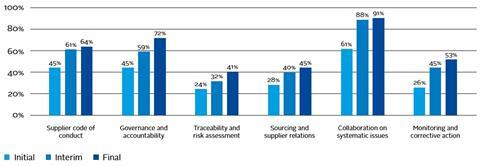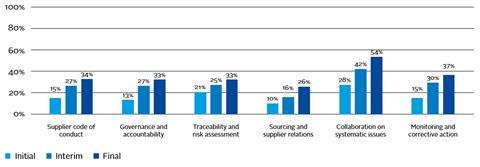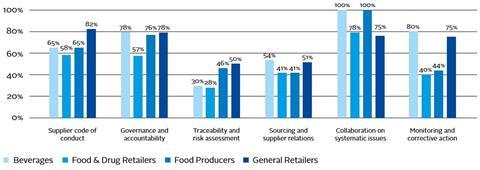Recommendations
Collaboration by investors can lead to improvement in corporate performance. The results of the second phase of this engagement on labour practices in agricultural supply chains show continuous improvement over time, but they also show there is still ground to cover for companies to fully identify, prevent and mitigate labour rights risks in their supply chains.
The engagement shows the need for dialogue between investors and companies to focus more on systemic issues and on how different policies and processes affect labour practices. A more holistic understanding of the impact of companies’ practices on labour rights is needed, as is greater attention to the implementation of different policies and the monitoring of impacts.
The PRI suggests the following recommendations for investors who would like to continue with this engagement. They should:
- Set objectives around systemic issues, such as measurable objectives (i.e. paying living wages to tier 1 and tier 2 suppliers, reporting on full traceability of key commodities’ supply chains and eliminating any type of forced labour throughout the supply chain). Understanding systemic issues around labour rights in supply chains will inform the steps necessary to bring about change for the whole sector.
- Assess company’s preparedness to achieve set objectives by making use of the indicator categorisation in Appendix 1 (basic, standard and leading), assess the level of preparedness of different companies against the desired objective and tailor company engagement accordingly. This assessment should provide a guidance on where to start the conversation with different companies for a more effective engagement.
- Collaborate to achieve progress. Collaboration can enhance efforts to change practices not only for companies but within sectors and can enable engagements to be more effective and efficient as investors share costs and resources.
Appendix 1 - Indicator categories and criteria
The following table outlines the three categories of indicators to use to assess the preparedness of companies in identifying, preventing and mitigating labour right risks in supply chains.
These three categories of indicators are intended to serve as a tool for investors in two ways: first by helping investors assess a given company’s preparedness to identify, prevent and mitigate labour rights risks in its supply chain, and second by using the assessment to tailor engagement efforts depending on levels of performance against set measurable objectives.
- Basic indicators form the basis on which investors may start the discussion with companies that are in the very early stages of supply chain management. Most target companies in this engagement have already met these indicators.
- Standard indicators are those that demonstrate companies’ further commitment to respecting labour rights in supply chains. These indicators cover the implementation of existing policies and the necessary mechanisms to monitor the effectiveness of such policies and practices.
- Leading indicators are those that show long-term commitment by companies to address systemic issues and work with suppliers in risk prevention and mitigation, but also in providing remedy to those affected by abuses directly or indirectly linked to their operations. Leading indicators focus on impact and outcome measurement rather than simply standard supply chain management.
Investors can use the indicator categories to tailor their discussion and engagement asks according to the level of awareness and preparedness of the company. The colours in the table denote which indicators relate to policies and processes and which relate to implementation and performance.
Appendix 2 - Results of the second phase of the engegement
The evaluation of companies was divided into two main sections: policy and processes, and implementation and performance. Policy and processes refers to the management of labour practices in supply chains in order to create the right incentives within the business, whereas implementation and performance refers to the application of the different policies and processes and the measurement of progress towards the desired objectives.
The following graphs show the overall performance over the course of three evaluations (initial, interim and final) of the 30 companies assessed for this engagement, with Figure 3 showing policy and processes and Figure 4 implementation and performance. The graphs show that companies have improved consistently in all areas assessed since the initial evaluation.
In order to compare companies’ scores between different sections of the scorecard, final scores were normalised to indicate scores based on percentages rather than absolute totals.
Figure 3: Overall results - policy and processes

Figure 4: Overall results - implementation and performance

The graphs below show the overall performance of each sector on the final evaluation (Figure 5 for policy and processes and Figure 7 for implementation and performance). Graphs 6 and 8 capture the maximum score achieved for each indicator by at least one company. This representation of the maximum score shows that the indicators used are not aspirational given that some companies are already fulfilling the requirements to score the full mark.
Overall, this demonstrates that what is often considered as “best practice” or aspirational can realistically be achieved and, therefore, it is reasonable to ask that these standards be met by investee companies, whether in regards to the policy and processes they put in place or how they go about implementing them and tracking progress.
Figure 5: Sector Results - Policy and Processes

Figure 6: Maximum score achieved – Policy and Processes

Figure 7: Sector Results - Implementation and Performance

Figure 8: Maximum score achieved – Implementation and Performance













